
CROMPTON HISTORYThis page contains a short history of the Cromptons. For the latest news on the status of each 33, see the Status and News pages. For a fuller history, see the Links page for other Crompton web sites, books and videos. If you have any comments or corrections to make to this page, please let me know, see link at bottom of page. |
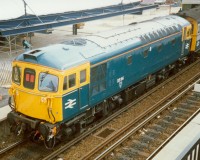
|
Origins
The Southern Region of British Rail ordered 65 locomotives as part of the Kent Coast electrification scheme. The order went to Birmingham Railway Carriage and Wagon Company (BRCW) of Smethick, Birmingham. The scheme was designed to replace all steam locomotives in Kent. The first 65 were works numbers DEL 92-156, and were delivered 1960 and 1961. The order was soon increased to 98 locomotives, works numbers DEL 169-189 were the same as the first order, and delivered 1961 and 1962.
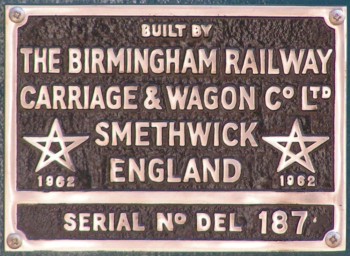
|
Worksplate from D6583 (33063). |
The last 12 locomotives were of a separate batch, works numbers DEL 157-168, and were 7 inches narrower, to enable working through the restricted tunnels of the Hastings line. This last 12 were delivered in 1962, D6597 being the last BRCW locomotive apart from D0260 LION. The company closed through lack of orders in 1963.
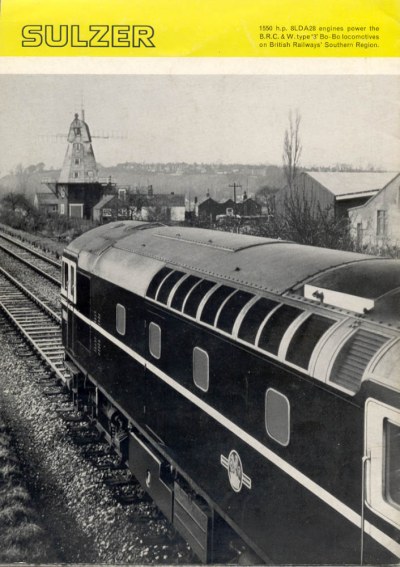
|
The back cover of a Sulzer publicity brochure, showing a new BRCW Type 3 Locomotive. David Hills |
All locomotives were delivered in standard BR loco green, most being repainted BR blue during the late 1960s and early 1970s. See the Livery page for full details. During 1967, 19 of the locomotives were fitted with push-pull equipment for use on the Bournemouth line. In 1969 the 12 Hastings line locos were fitted with slow speed control, for working Merry-go-round trains.
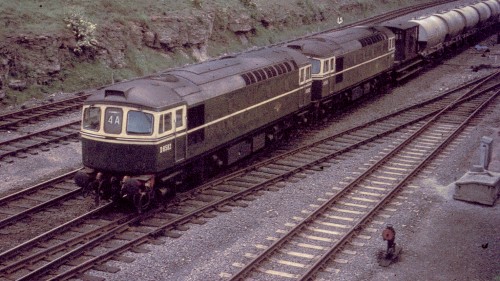
|
D6582 (33062) and D6581 (33061) at Little Bytham on the East Coast Main Line in June 1962. Photo by Chris Aston |
Duties
The class worked all kinds of duties on the Southern Region, including passenger trains on the Portsmouth Harbour - Cardiff, Waterloo - Exeter and London Bridge - Uckfield lines.
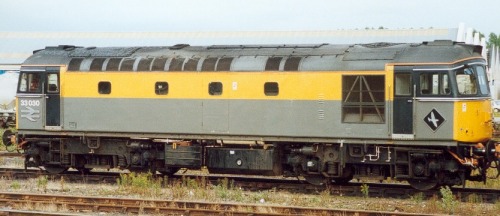
|
33030 in the sidings behind Eastleigh station, on the 10th September 1993. Painted in Civil Engineers "Dutch" Livery. Note the Eastleigh depot plaque showing a Spitfire aircraft. |
Specification
The locomotives were of a new design, based on the BRCW Type 2 (later Class 26), with a larger engine. They are powered by a Sulzer 8 cylinder in-line engine of 1550 bhp, designated 8LDA. The main generator and the four traction motors were supplied by Crompton Parkinson, hence the nickname. They were the first BR diesel locomotives to have electric train heating.
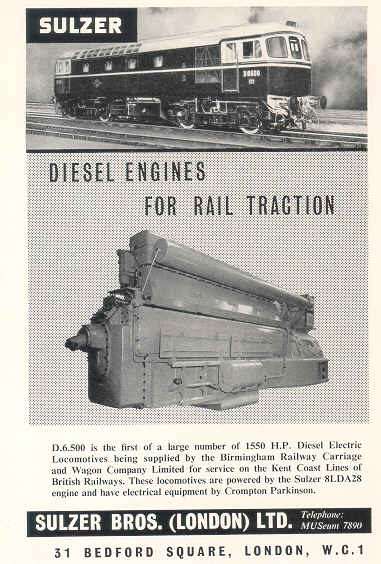
|
The Sulzer 8LDA Engine |
They are 50' 9" long, 12' 8" high, and 9' 3" wide. The Hastings line locomotives are 8' 8" wide. They weigh around 76½ tons, and have a fuel capacity of 800 gallons. The maximum speed is 85 mph, although this was later reduced for some locomotives near the end of their working lives.
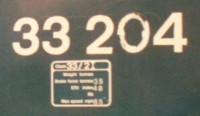
|
The number and TOPS Data panel on 33204 |
Numbering
The original numbers were D6500-D6585 for the standard locos, and D6586-D6597 for the narrow ones. The Southern Region gave them class designations of KA-2B (standard), KB (push-pull), and KA-4C (narrow).
Around 1973 all locomotives were renumbered in the TOPS scheme, they became Class 33/0 - 33001-33065 (standard), Class 33/1 - 33101-33119 (push-pull), Class33/2 - 33201-33212 (narrow). The class 33/1s were originally to have been Class 34. Two locomotives, D6502 and D6576 with withdrawn because of accident damage before this renumbering took place. 33205 was briefly renumbered 33302 during 1988. See the Status page for full numbering scheme.
Modifications
The major changes to the class, apart from the 33/1 conversions were the fitting of High Intensity Square Headlights from 1991 (33002/8/12/9/20/1/3/5/6/9/30/5/40/2/6/7/8/51/2/3/7/63/4/5/101/2/3/8/9/16/7/8/201/2/4/6/7/8/11), and Cab-to-shore Radio Pods from 1992 (33002/8/12/9/21/5/6/30/5/46/7/8/51/2/3/7/63/4/5/103/8/9/16/7/201/2/4/6/7/8/11).
Withdrawal
As well as the 2 locos mentioned above, 33036 (1979), and 33041 (1975) were also early casualties. Mass withdrawal started in 1985, due to loss of goods traffic, and replacement on passenger duties by Sprinter DMUs. Around 40 locos passed to EWS on the breakup of British Rail in 1998. These were gradually whittled down to 7 locos at the beginning of 1998, in Decemeber of that year, the last 2 in service were switched off.
Three locomotives were subsequently re-instated and sent to work trip duties based in Abeerdeen. Of these, 33025, and 33030 are working, with 33019 as a spare parts donor. See the Status page for latest details.
Preservation
The first loco bought for preservation was 33034 in May 1990, many have followed since. See the Status page for the current owners. Some have now been re-certified for mainline use. Others have been painted in non-authentic liveries, see the Livery page.